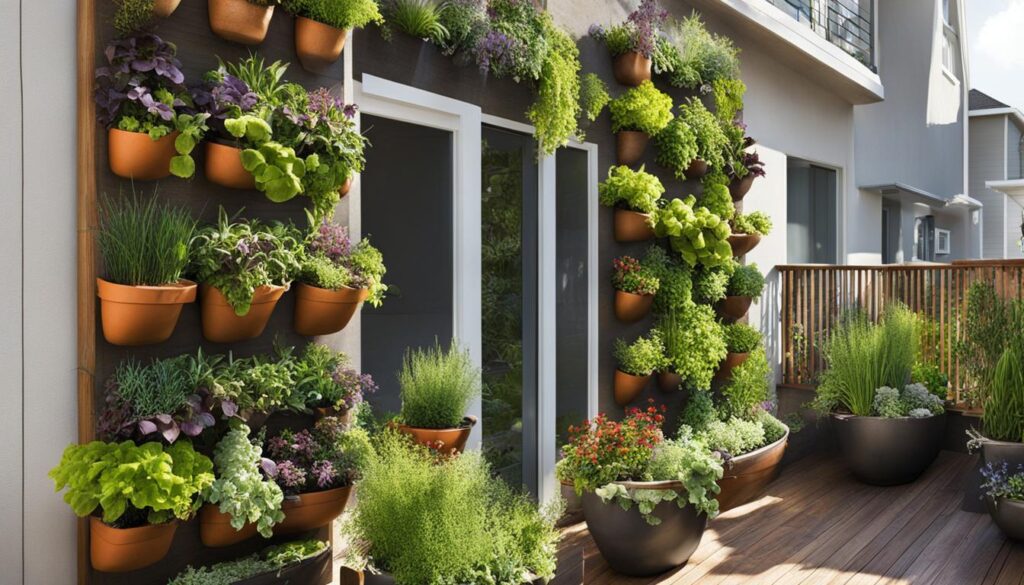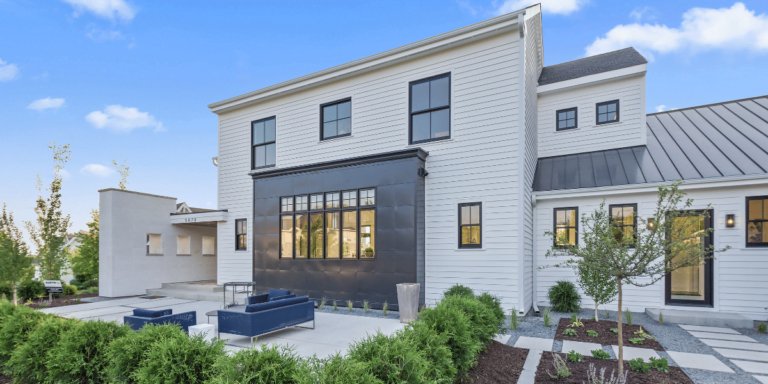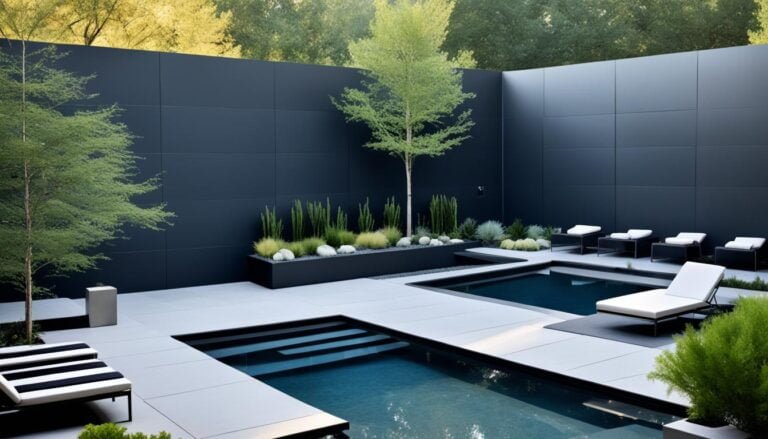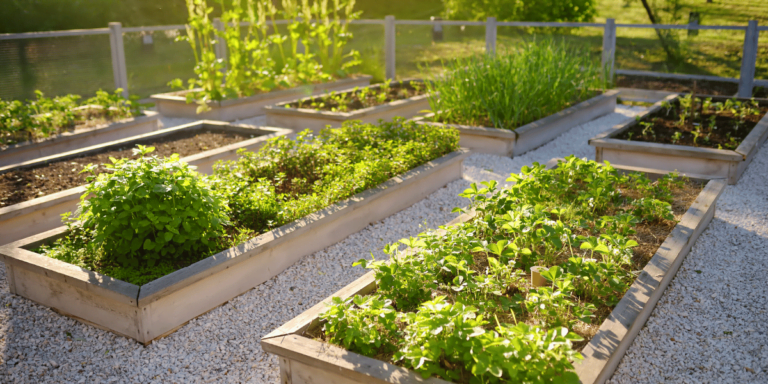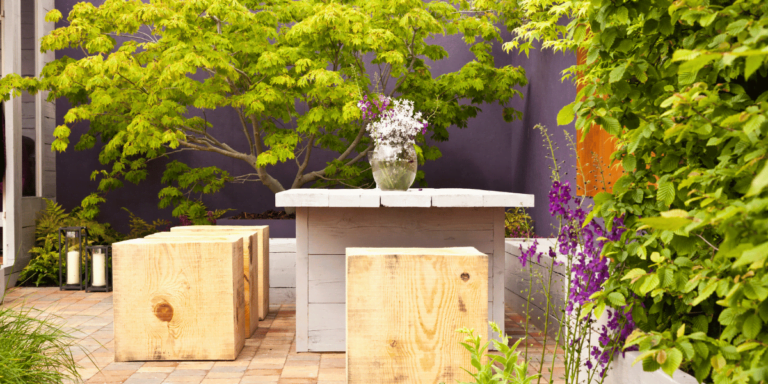Welcome to the world of small space gardening, where urban dwellers can unleash their green thumbs and create eco-friendly oases in the midst of concrete jungles. Whether you have a cozy balcony, a tiny backyard, or even just a sunny windowsill, there are plenty of ways to transform your limited space into a sustainable and fruitful garden.
One of the key strategies for maximizing yield in small gardens is to utilize intensive planting techniques and choose compact vegetable varieties that are well-suited for small spaces. With vertical gardening methods, you can grow plants upwards, making efficient use of every inch of available space. By selecting high-yield plants, you’ll be amazed at the bountiful harvest you can achieve even in the smallest of gardens.
Key Takeaways:
- Implement intensive planting and choose compact vegetable varieties.
- Utilize vertical gardening methods to make the most of limited space.
- Select high-yield plants for a bountiful harvest.
- Create an eco-friendly urban oasis.
- Embrace sustainable and efficient gardening practices.
Choosing the Right Location for Your Small Garden
When it comes to small space gardening, choosing the right location for your garden is of utmost importance. Several factors need to be considered, including sunlight exposure, soil quality, drainage, and convenience. Let’s explore each of these aspects to help you make an informed decision.
Sunlight Exposure
Sunlight is vital for the growth and productivity of your plants. It’s crucial to select a spot that receives at least six to eight hours of direct sunlight per day. Observing the movement of the sun throughout the day can help identify areas in your yard that get the most sunlight. Keep in mind that different crops have varying sunlight requirements, so choose a location that suits the plants you intend to grow.
Soil Quality and Drainage
The soil quality and drainage play a significant role in the success of your small garden. Ensure that the soil is fertile, well-draining, and rich in organic matter. Conduct a soil test to determine its pH level and nutrient content. This will help you make any necessary amendments to create an optimal growing environment for your plants. Consider adding compost or aged manure to improve the soil structure and fertility.
Convenient Garden Location
Another factor to consider is the convenience of the garden location. Choose a spot that is easily accessible for regular maintenance tasks such as watering, weeding, and harvesting. If the garden is too far from your house or has difficult accessibility, it may discourage you from tending to your plants regularly, leading to decreased productivity. Optimal accessibility will ensure you can enjoy the process of gardening and stay committed to nurturing your plants.
By carefully considering these factors, you can select the perfect location for your small garden, providing it with the necessary sunlight, soil quality, drainage, and convenience it needs to thrive.
| Factors to Consider for Choosing the Right Location | Sunlight Exposure | Soil Quality and Drainage | Convenient Garden Location |
|---|---|---|---|
| Importance | High | High | High |
| Considerations | Select a spot with at least 6-8 hours of direct sunlight per day | Ensure the soil is fertile, well-draining, and rich in organic matter | Choose a location that is easily accessible for regular maintenance tasks |
| Benefits | Promotes healthy plant growth and productivity | Provides optimal growing conditions for plants | Allows for convenient maintenance and care |
Preparing the Soil for Your Small Garden
Proper soil preparation is essential for maximizing yield in a small garden. It lays the foundation for healthy plant growth and ensures optimal nutrient availability. To create a nutrient-rich soil environment, follow these steps:
1. Test Your Soil
Begin by testing your soil to determine its pH level and nutrient content. This will help you identify any deficiencies or imbalances that need to be addressed. Soil testing kits are readily available at garden centers and online, making it easy to assess the health of your soil.
2. Make Necessary Adjustments
Based on the results of your soil test, adjust the pH level if needed. Most vegetables prefer a slightly acidic to neutral soil pH, around 6.0 to 7.0. To raise the pH, add lime, and to lower it, add sulfur or peat moss. Additionally, amend the soil with organic matter to improve its structure and fertility.
3. Add Organic Matter
Organic matter, such as compost or aged manure, is a valuable addition to your soil. It improves drainage, retains moisture, and enhances nutrient availability. Mix in a generous amount of compost or aged manure into the top few inches of soil to enrich it with organic matter.
4. Consider Soil Amendments
In some cases, your soil may require specific amendments to meet the nutritional needs of your plants. Common soil amendments include bone meal for phosphorus, blood meal for nitrogen, and greensand for potassium. Follow the recommended application rates based on your soil test results and the requirements of your chosen crops.
5. Optimize Growing Conditions
For container gardening and raised beds, consider using a nutrient-rich potting mix. These mixes are specially formulated to provide an ideal balance of nutrition, moisture retention, and aeration for potted plants. They can help create an optimal growing environment for your plants in small spaces.
Following these soil preparation steps will ensure that your small garden has a nutrient-rich soil foundation, setting the stage for healthy and productive plants.
Selecting the Right Crops for Small Gardens
Choosing the right crops is crucial for maximizing yield in a small garden. By opting for compact vegetable varieties and high-yield plants, you can make the most of limited space and achieve a bountiful harvest.
One effective technique for small space gardening is interplanting, where different crops are grown in the same space. This allows you to optimize the use of available area and increase overall productivity. Additionally, employing succession planting ensures a continuous supply of fresh produce throughout the growing season. By planting new crops as soon as others are harvested, you can extend the harvest period and maximize your yield.
Example Crops for Small Gardens:
When selecting crops for your small garden, consider those that are well-suited to compact spaces. Here are some examples:
- Cherry tomatoes: Compact varieties of cherry tomatoes, such as ‘Tiny Tim’ or ‘Window Box Roma’, thrive in small gardens and produce an abundance of flavorful fruits.
- Bush beans: Varieties like ‘Provider’ or ‘Contender’ are compact in size and yield a generous crop of tender beans.
- Lettuce: Leafy greens like ‘Salad Bowl’ or ‘Black-Seeded Simpson’ are perfect for small gardens, as they can be harvested as young leaves and take up minimal space.
- Herbs: Culinary herbs like basil, parsley, or chives are compact and versatile, making them excellent choices for small gardens. They can be interplanted with other vegetables or grown in containers.
By carefully selecting suitable crops, utilizing interplanting and succession planting techniques, and considering the specific needs of your small garden, you can create a productive and thriving space that yields an abundant harvest.
Making the Most of Limited Space: Space-Saving Techniques
If you have a small garden, it’s important to make the most of your limited space. By utilizing space-saving techniques, you can maximize your yield and create a productive garden oasis. Here are some strategies to consider:
Container Gardening
Container gardening is a versatile solution for small spaces. By using pots, planters, or hanging baskets, you can grow a variety of plants, even if you don’t have a traditional garden bed. Container gardening provides flexibility, allowing you to move your plants around to optimize sunlight or enhance visual appeal. Consider placing containers on balconies, patios, or window sills to make the most of vertical space.
Vertical Gardening
Vertical gardening is an excellent way to utilize vertical space and grow more plants in a small area. By utilizing trellises, arbors, or walls, you can train vining plants to grow upward, saving valuable ground space. This technique is especially useful for growing climbing vegetables, such as cucumbers, beans, or peas. Vertical gardening not only maximizes your yield but also adds visual interest to your garden.
Raised Beds
Raised beds offer several advantages for small gardens. They provide better soil control and drainage, allowing for healthier plant growth. Additionally, raised beds create a barrier against pests and weeds, reducing maintenance efforts. By building raised beds of varying heights, you can create a tiered garden design to further optimize space utilization. Consider using raised beds for growing vegetables, herbs, or flowers in your small garden.
Interplanting
Interplanting is a technique where different plants are grown closely together, maximizing space between plants. By choosing companion plants that have compatible growth habits and nutrient requirements, you can optimize yield and reduce competition for resources. Interplanting can be done in traditional garden beds, containers, or raised beds, creating a vibrant and productive garden.
Using Vertical Space
In a small garden, it’s crucial to make use of every available inch. Use trellises, hanging planters, or wall-mounted systems to take advantage of vertical space. Consider growing herbs, strawberries, or even small fruits on a trellis or wall, freeing up ground space for other plants. By using vertical space effectively, you can create a lush and productive garden in even the smallest of areas.
Comparison of Space-Saving Techniques
| Technique | Advantages | Disadvantages |
|---|---|---|
| Container Gardening | – Flexibility to move plants – Utilizes small spaces – Adds visual appeal | – Requires regular watering – Limited soil volume |
| Vertical Gardening | – Maximizes vertical space – Increases plant density – Adds aesthetic value | – Requires sturdy support structures – May have limited sunlight exposure for some plants |
| Raised Beds | – Better soil control – Reduces weed growth – Provides easy access for maintenance | – Initial cost and labor to build – Limited planting area |
| Interplanting | – Maximizes space between plants – Enhances companion planting – Increases biodiversity | – Requires careful planning – May have competition for resources |
| Using Vertical Space | – Efficient use of available space – Expands growing area – Adds vertical interest to the garden | – Requires proper support structures – May have limited accessibility for maintenance |
By implementing these space-saving techniques such as container gardening, vertical gardening, raised beds, interplanting, and using vertical space, you can transform your small garden into a thriving oasis. These strategies not only optimize space utilization but also add visual appeal and increase your overall yield. Get creative and make the most of every inch in your small garden!
Extending the Growing Season in Small Gardens
In order to maximize yield in a small garden, it’s essential to extend the growing season. By utilizing season-extending techniques and planning ahead, you can ensure a continuous supply of fresh produce throughout the year. Let’s explore some effective strategies for season extension:
1. Hoop Tunnels
One popular method for extending the growing season is using hoop tunnels. These structures consist of arched hoops covered with greenhouse plastic or row cover fabric, creating a protected environment for your plants. The plastic or fabric helps retain heat, safeguarding your crops from frost and providing an extended growing period.
2. Raised Beds
Raised beds can also contribute to season extension in small gardens. The elevated soil level in raised beds helps warm up earlier in the spring, allowing you to start planting sooner. Additionally, raised beds offer better drainage and can protect your crops from excessive rainfall, giving you more control over the growing conditions.
3. Succession Planting
Succession planting is the practice of planting crops at intervals to ensure a continuous harvest. By planting different crops throughout the growing season, you can stagger their maturity dates and make the most of limited space. This technique not only extends the harvest period but also maximizes productivity by utilizing the available garden area more efficiently.
4. Planning Ahead and Indoor Seed Starting
Proper planning and indoor seed starting are crucial for extending the growing season. Start seeds indoors several weeks before the last frost date in your area. This allows plants to establish themselves and gives you a head start when transplanting them to your garden. By starting early, you can take advantage of the longer growing period and enjoy an extended harvest.
By implementing these season-extending techniques, small garden enthusiasts can overcome the limitations of shorter growing seasons and optimize their harvests. The ability to grow fresh produce for a longer duration provides an opportunity to savor the flavors of homegrown vegetables throughout the year.
Conclusion
Small space gardening offers a world of possibilities for maximizing yield and enjoying the rewards of your labor. By implementing space-saving techniques, such as vertical gardening and container gardening, you can make the most of limited space and still cultivate a bountiful harvest. Choosing the right crops, such as compact vegetable varieties and high-yield plants, further boosts your garden’s productivity.
In addition, season extension techniques, like using hoop tunnels and practicing succession planting, allow you to extend the growing season and enjoy fresh produce for longer periods. Whether you have a tiny balcony or a small backyard, small space gardening empowers you to create a sustainable and efficient garden that provides you with a steady supply of homegrown goodness.
Embrace the possibilities of small space gardening and let your creativity bloom. With the right planning, care, and use of space-saving techniques, your small garden can thrive and provide you with an abundance of delicious and nutritious fruits, vegetables, and herbs. Start your small space gardening journey now and experience the joy of growing your own food in even the smallest of spaces.
Frequently Asked Questions
How can I maximize my yield in a small space garden?
To maximize your yield in a small space garden, you can implement techniques such as intensive planting and choosing compact vegetable varieties. By using vertical gardening methods and selecting high-yield plants, you can make the most of your limited space and achieve a bountiful harvest.
What factors should I consider when choosing a location for my small garden?
When selecting a location for your small garden, it is crucial to consider factors such as sunlight exposure, soil quality, drainage, and convenience. Choose a spot that receives at least six to eight hours of direct sunlight per day and has well-draining soil. Additionally, ensure that the location is easily accessible for regular maintenance of your garden.
How should I prepare the soil for my small garden?
Proper soil preparation is essential for maximizing yield in a small garden. Test your soil to determine its pH level and nutrient content and make any necessary adjustments. Adding organic matter such as compost or aged manure can improve soil structure and fertility. Consider using a nutrient-rich potting mix for container gardening and raised beds to provide optimal growing conditions for your plants.
What crops should I choose for a small garden?
Choosing the right crops is crucial for maximizing yield in a small garden. Opt for compact vegetable varieties and high-yield plants that are well-suited to small spaces. Consider interplanting different crops in the same space and utilizing succession planting to extend your growing season and maximize harvest. Some examples of suitable crops for small gardens include cherry tomatoes, bush beans, lettuce, and herbs.
How can I make the most of limited space in a small garden?
To make the most of limited space in a small garden, consider space-saving techniques such as container gardening, vertical gardening, and raised beds. Containers allow for flexibility and can be placed on balconies or patios. Vertical gardening utilizes trellises or walls to grow plants vertically, saving space. Raised beds provide better soil control and allow for more efficient use of space. Interplanting and using vertical space are additional strategies to maximize yield in small gardens.
How can I extend the growing season in a small garden?
Extending the growing season is key to maximizing yield in a small garden. Utilize season-extending techniques such as hoop tunnels and raised beds to start planting earlier in the season and protect your crops from frost. Practice succession planting to stagger harvest times and make the most of limited space. Planning ahead and starting seeds indoors can also help extend the growing season and ensure a continuous supply of fresh produce.



